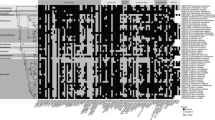Abstract
The abilities of six genotypes of two putative Helotiales ascomycete ericoid mycorrhizal fungal taxa from Woollsia pungens and Leucopogon parviflorus (Ericaceae) to utilise glucose, galactose, mannose, cellobiose, carboxymethylcellulose, crystalline cellulose, starch and xylan as sole carbon sources were tested in axenic liquid culture. With the exception of all taxon II isolates on carboxymethylcellulose, all genotypes of both taxa produced measurable biomass on all substrates. Significant intraspecific variation was observed in biomass production on all substrates. While pooled data for all genotypes of each taxon revealed significant interspecific differences in biomass production on carboxymethylcellulose, glucose, cellobiose, and starch, mean biomass production for each taxon on the latter three substrates differed less than threefold, suggesting that the saprotrophic abilities of the two taxa are broadly similar.



Similar content being viewed by others
References
Bending GD, Read DJ (1996a) Effects of the soluble polyphenol tannic acid on the activities of ericoid and ectomycorrhizal fungi. Soil Biol Biochem 28:1595–1602
Bending GD, Read DJ (1996b) Nitrogen mobilization from protein-polyphenol complex by ericoid and ectomycorrhizal fungi. Soil Biol Biochem 28:1603–1612
Burke RM, Cairney JWG (1997a) Carbohydrolase production by the ericoid mycorrhizal fungus Hymenoscyphus ericae under solid state fermentation conditions. Mycol Res 101:1135–1139
Burke RM, Cairney JWG (1997b) Purification and characterisation of a β-1,4-endoxylanase from the ericoid mycorrhizal fungus Hymenoscyphus ericae. New Phytol 135:345–352
Burke RM, Cairney JWG (1998) Carbohydrate oxidases in ericoid and ectomycorrhizal fungi: a possible source of Fenton radicals during the degradation of lignocellulose. New Phytol 139:637–465
Cairney JWG (1999) Intraspecific physiological variation: implications for understanding functional diversity in ectomycorrhizal fungi. Mycorrhiza 9:125–135
Cairney JWG, Ashford AE (2002) Biology of mycorrhizal associations of epacrids (Ericaceae). New Phytol 154:305–326
Cairney JWG, Burke RM (1998) Extracellular enzyme activities of the ericoid mycorrhizal endophyte Hymenoscyphus ericae (Read) Korf & Kernan: their likely roles in decomposition of dead plant tissue in soil. Plant Soil 205:181–192
Cairney JWG, Meharg AA (2003) Ericoid mycorrhiza: a partnership that exploits harsh edaphic conditions. Eur J Soil Sci (in press)
Cairney JWG, Sawyer NA, Sharples JM, Meharg AA (2000) Intraspecific variation in nitrogen source utilisation by isolates of the ericoid mycorrhizal fungus Hymenoscyphus ericae (Read) Korf and Kernan. Soil Biol Biochem 32:1319–1322
Jennings DH (1995) The physiology of fungal nutrition. Cambridge University Press, Cambridge
Leake JR, Read DJ (1997) Mycorrhizal fungi in terrestrial habitats. In: Wicklow D, Söderström B (eds) The mycota. IV. Environmental and microbial relationships. Springer, Berlin Heidelberg New York, pp 281–301
Marx DH, Bryan WC (1975) Growth and ectomycorrhizal development of loblolly pine seedlings in fumigated soil infested with the fungal symbiont Pisolithus tinctorius. For Sci 21:245–254
Meletiadis J, Meis JFGM, Mouton JW, Verweij PE (2001) Analysis of growth characteristics of filamentous fungi in different nutrient media. J Clin Microbiol 39:478–484
Midgley DJ, Chambers SM, Cairney JWG (2002) Spatial distribution of fungal endophyte genotypes in a Woollsia pungens (Ericaceae) root system. Aust J Bot 50:559–565
Pearson V, Read DJ (1975) The physiology of the mycorrhizal endophyte of Calluna vulgaris. Trans Br Mycol Soc 64:1–7
Perotto R, Bettini V, Bonfante P (1993) Evidence of two polygalacturonases produced by a mycorrhizal ericoid fungus during its saprotrophic growth. FEMS Microbiol Lett 114:85–92
Perotto S, Perotto R, Faccio A, Schubert A, Varma A, Bonfante P (1995) Ericoid mycorrhizal fungi: cellular and molecular bases of their interactions with the host plant. Can J Bot 73:S557-S568
Perotto S, Coisson JD, Perugini I, Cometi V, Bonfante P (1997). Production of pectin-degrading enzymes by ericoid mycorrhizal fungi. New Phytol 135:151–162
Piercey MM, Thormann MN, Currah RS (2002) Saprobic characteristics of three fungal taxa from ericalean roots and their association with the roots of Rhododendron groenlandicum and Picea mariana in culture. Mycorrhiza 12:175–180
Read DJ (1996) The structure and function of the ericoid mycorrhizal root. Ann Bot 77:365–374
Read DJ, Perez-Moreno J (2003) Mycorrhizas and nutrient cycling in ecosystems — a journey towards relevance? New Phytol 157:475–492
Reed ML (1989) Ericoid mycorrhizas of Styphelieae: intensity of infection and nutrition of the symbionts. Aust J Plant Physiol 16:155–160
Straker CJ (1996) Ericoid mycorrhiza: ecological and host specificity. Mycorrhiza 6:215–225
Thormann MN, Currah RS, Bayley SE (2002) The relative ability of fungi from Sphagnum fuscum to decompose selected carbon substrates. Can J Microbiol 48:204–211
Tuohy MG, Walsh DJ, Murray PG, Claeyssens M, Cuffe MM, Savage AV, Coughlan MP (2002) Kinetic parameters and mode of action of the cellobiohydrolases produced by Talaromyces emersonii. Biochim Biophys Acta 1596:366–380
Varma A, Bonfante P (1994) Utilisation of cell-wall related carbohydrates by ericoid mycorrhizal endophytes. Symbiosis 16:301–313
Wiese J, Kleber R, Hampp R, Nehls U (2000) Functional characterization of the Amanita muscaria monosaccharide transporter AmMst1. Plant Biol 2:278–282
Xiao G, Berch SM (1999) Organic nitrogen use by salal ericoid mycorrhizal fungi from northern Vancouver Island and impacts on growth in vitro of Gaultheria shallon. Mycorrhiza 9:145–149
Acknowledgements
We thank the NSW National Parks and Wildlife Service for permission to obtain isolates of Woollsia pungens and Leucopogon parviflorus plants in the Blue Mountains National Park. We are also grateful to Dr. Ron Burke for his comments on cellulase activities.
Author information
Authors and Affiliations
Corresponding author
Rights and permissions
About this article
Cite this article
Midgley, D.J., Chambers, S.M. & Cairney, J.W.G. Utilisation of carbon substrates by multiple genotypes of ericoid mycorrhizal fungal endophytes from eastern Australian Ericaceae. Mycorrhiza 14, 245–251 (2004). https://doi.org/10.1007/s00572-003-0262-5
Received:
Accepted:
Published:
Issue Date:
DOI: https://doi.org/10.1007/s00572-003-0262-5




